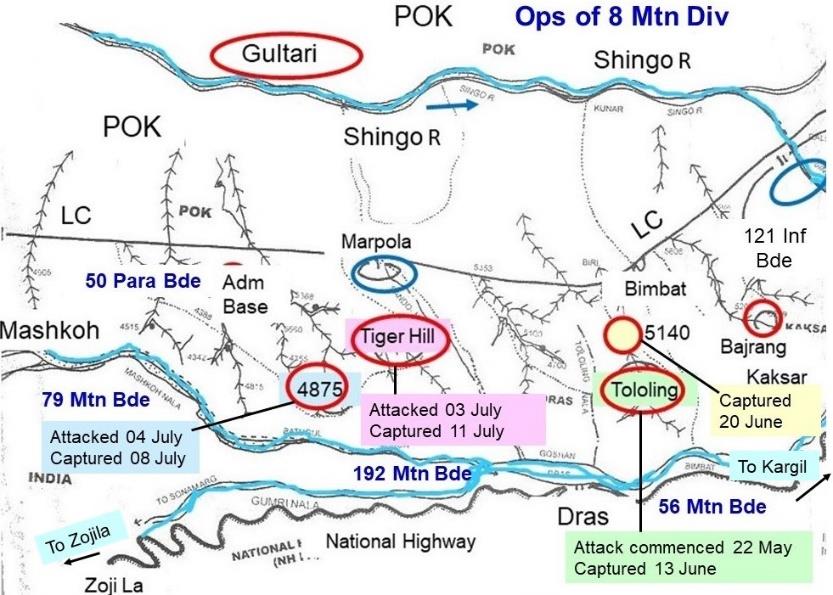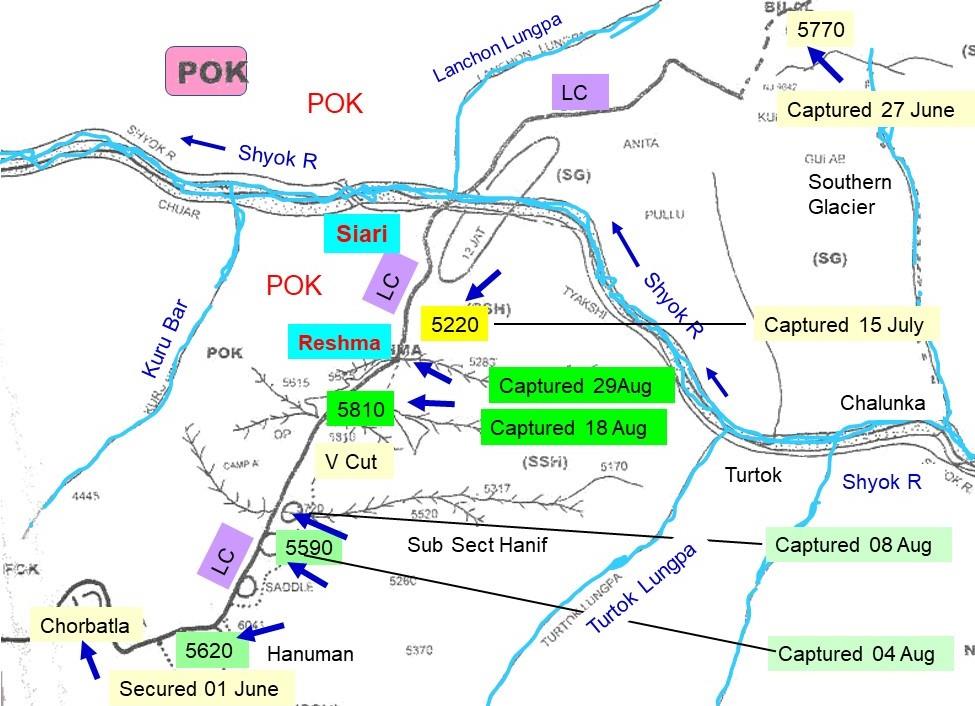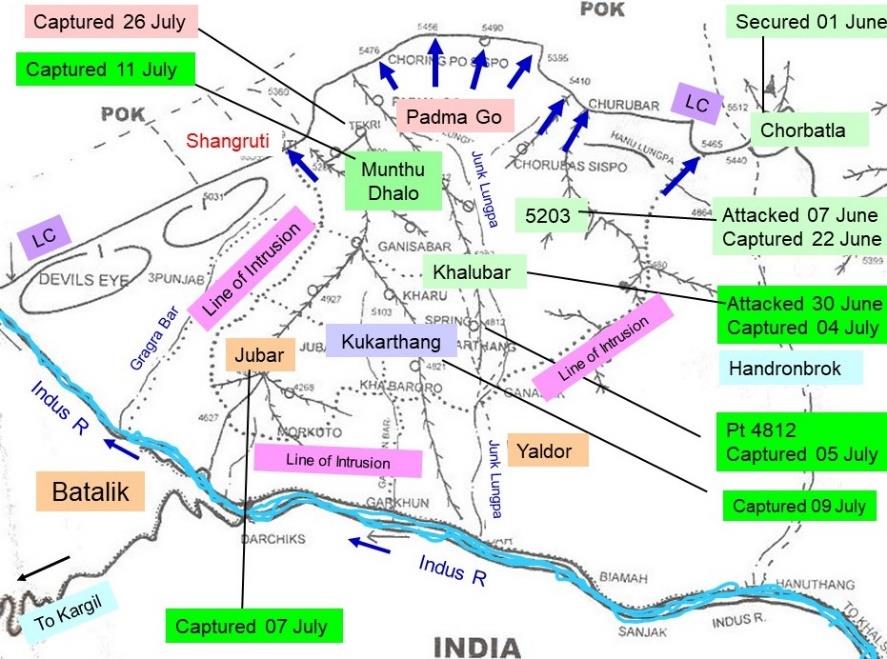Kargil 1999
After the elections in J&K in 1996, normalcy was returning to the State gradually under an elected government. This did not suit Pakistan whose new Army Chief decided to up the ante. Taking advantage of the ineffective surveillance grid of the Line of Control (LC)north of Zojila, Pakistan infiltrated specially trained Northern Light Infantry (NLI) troops to interdict the highway from Zojila to Kargil, and to occupy some additional area across the LC. Pak soldiers were well armed and well supported.
Indian commanders took time to grasp the magnitude of the incursions. A blame game commenced and panic in the minds of senior officers led to hasty, ill-planned attacks and unnecessary casualties. Notably, the three Services planned separate operations, Op Vijay, Op Safed Sagar and Op Talwar.
6 Mountain Division was trained for such an eventuality and was moved to J&K, but for some reason it was not employed. Instead, 8 Mountain Division was moved from the Kashmir Valley to Dras by 01 June 1999. After adequate recce and preparations, they commenced attacks on 12 June and recaptured the heights overlooking the National Highway, by 11 July 1999. 50 Para Brigade then cleared the area up to the LC; see map.

Dras Sector 1999
Meanwhile, 3 Infantry Division cleared the Batalik sector, followed by heights in Turtok sector (Sub Sector Hanif or SSH) in August. Trained personnel from HAWS (High Altitude Warfare School) assisted all formations. All attacks were multi directional, making best use of terrain. Skilled mountaineers executed cliff assaults wherever possible, to achieve surprise. Attempts were made to get behind the enemy positions wherever space permitted, but these were not successful, particularly in the Dras Sector.

Sub Sector Hanif 1999
Artillery provided effective support. 20 fire units were deployed in Dras and 15 in Batalik. While GOC 8 Mountain Division ensured fire support of minimum 18 fire units for each attack, in other sectors, some battalions had to attack with just two to four fire units13, which reflects on the formation commanders and artillery advisers. The system of ‘direct – indirect’ fire was applied in Dras with the Bofors guns firing direct and the fire being corrected by forward observation officers.

Batalik Sector 1999
The IAF took time to deploy and commence attacks. The delay enabled the Pakistanis to strengthen their defences even during May, which increased the difficulties for the ground attacks. The loss of two fighter aircraft and one helicopter by shoulder fired Surface to Air Missiles (SAMs), necessitated flying high, which affected accuracy14. Even the designators of the precision guided munitions (PGMs), had to be flown high, reducing accuracy. Pakistani gun areas and administrative bases were ideal targets for Air, but most of these remained beyond limits due to restrictions on crossing the LC, which was a government decision. Thus, despite skilful flying by the brave pilots , the IAF strikes were not effective on the peaks and razor-sharp ridges, though the psychological effect of air strikes was tremendous.
The rest of the Army, Navy and IAF deployed for possible escalation. The MEA (Ministry of External Affairs) explained our case abroad and swung international opinion in our favour. The combined effect of all these actions forced the Pakistani Government to withdraw their soldiers.
The Kargil war was conducted well by the Government. Questions have been raised about the decision not to cross the LC but that could have led to all-out war. This needs a debate keeping in mind all relevant factors that existed in mid-1999.
There has been discussion about responsibility for lackadaisical surveillance of the LC, which encouraged Pakistanis to plan the intrusions. There is unanimity of thought that all commanders in the chain of command were responsible in different measure but the fact is that no senior officer accepted moral responsibility.
Reflections and Recommendations
An overview of the wars indicates that the Indian Armed Forces have largely acquitted themselves well. The political direction of war was atrocious to begin with but picked up after 1962 and has not been found wanting thereafter. The strength of the Army has been its young officers, always and every time; but one does not hear the same comment about senior officers.
Although, compared to the American, British or Pakistanis, our Generals are much better, some of them have drawn adverse comments after operations. After Op Pawan the criticism was particularly severe (though this operation is not examined in this article). Therefore introspection is advisable.
In wars, professional competence of the Generals has been just satisfactory. Though they are masters in Operational Art in peace time, nowhere do we find this practised in war. Due to this lacuna, the Army has had to engage in many tactical battles that were unnecessary; capture at great human cost, objectives which had little importance; and fight under conditions of significant disadvantage. The political conservativeness results in a reactive defensive strategy which in turn constrains operational level operations. The statement, “We will fight with what we have” actually translates to the lack of political will to modernise the armed forces and employ hard power in securing and furthering national interests.
Be it in peace or during war, adversity has always led to panic followed by paralysis, from which senior officers take time to recover. Functioning in the ‘grey zone’ or the fog of war, the Generals have remained too confused to reorganise and utilise all their resources to advantage. There is a need to increase interoperability of formations to make these more versatile for employment in different environments and to facilitate multi-tasking for various contingencies.
This will also bring about considerable saving, which can be used for modernisation.
Another major lacuna has been little concern to minimise casualties. To recapitulate, number of fatal casualties in various wars have been, 2,814 in 1947-48; 3,175 in 1962; 3,375 in 1965; 3,836 in 1971 and 667 in 1999. These could be contrasted with Israeli casualties in three major wars in 1956 (231); 1967 (776); and in 1973 (2656). The Americans lost 149 soldiers in the Gulf War of 1991 though total casualties were 294.
We announce proudly that our young officers suffer disproportionately high casualties in wars; but then fail to do anything about it. Young officers are not cannon fodder! The Generals need to learn to execute tasks with fewer casualties.
Lack of synergy between the Services has resulted in limiting military gains in every war. The inability to work together is an undesirable weakness in senior officers and must be addressed. Similarly, senior officers must learn to function better with civil officials and political leaders, without compromising the interests of the Services.
A question arises: why do excellent officers, who make good COs, then go on to become mediocre senior officers? The excellence of the young officers indicates that the selection process and initial training are apt, but thereafter, the system develops leaders for peace, and not for war. In other words the officers have the potential to excel but the system encourages and promotes mediocrity. This deserves greater analysis, that is not possible in a review article, such as this one.
The Indian Nation is justifiably proud of its Indian armed forces, which enjoy the finest reputation in the world. it is up to the senior officers to carry out regular introspection to identify and eradicate weaknesses that creep into all organisations inevitably.
Notes
- https://en.wikipedia.org/wiki/Indo-Pakistani_War_of_1947–1948
- https://www.logically.ai/factchecks/library/dd11d968
- Neville Maxwell, India’s China War, Natraj Publisher, Dehradun, 1970, p 410
- Ibid, p 413
- SN Prasad and UP Thapliyal, The India-Pakistan War of 1965, p 23 to 38.
- ibid, p 151, 180.
- ibid, p 243
- In 1965, 11 Corps had seven armoured regiments and one motorised infantry battalion, excluding 61 Cav (horsed). These were 1 Horse, 3 Cav, 7 Lt Cav, 8 Lt Cav, 9 Horse, 14 Horse and CIH.
- Prasad and Thapliyal, p 190, Op Nepal.
- Ibid, pp 250, 251.
- SN Prasad and UP Thapliyal, The India – Pakistan War of 1971, p 206.
- ACM PC Lal, My Years with the IAF, Lancer Publication, New Delhi, 1986, pp 232 to 234
- Lt Gen YM Bammi, Kargil, the Impregnable Conquered, Gorkha Publishers, New Delhi, 2002, p 378, p 314 for 1 BIHAR two fire units, p 368 for 11 RAJRIF 4 fire units in Turtok Sector
- ibid, p 450





Fighting the war is the military’s job, but securing our rights after the war is the duty of the political and diplomatic machinery. As brought out by the author, India failed to press home the advantage which its military achieved.
The worst decision of 1948 was to halt offensive operations, when the Indian Army was better positioned to go all out to capture entire J&K. It must have been the aspirations of then PM Jawaharlal Nehru to play to the UN gallery to be a messiah of peace. Nehru again goofed it up with his Panchsheel in 1962.
Post 1965 war, it appeared that the Russians arm twisted Shastri to accept a peace deal brokered by them, resulting in India handing over most of the captured territories – including the most strategic Haji Pir pass.
Post 1971, Indian diplomats and politicians failed in securing a well defined deal when India had 93,000 prisoners of war.
Very well written article giving an abridged overview of Indian wars post independence, highlighting various shortcomings in planning and execution of operations at the macro level. Maps, particularly of the Western theatre, are illustrative and help understanding the progress of operations at a glance
A very well researched Article given iin a brief and concise manner. Simple language without jargon even to understand by non-military Personnel.. Lot of lessons have been brought out which need action by Politico Military heirarchy. Well done Gen KK Khanna.
5 Star Article.
Very well analysed and lessons at the strategic level brought out candidly. Let’s hope the senior leadership go in for a frank introspection to bring about more operational professionalism in services
Sir,
Wonderfully written article. Great learning for us. Thanks and Regards.
Wonderfully written article, well thought out and analysed. Unfortunately we haven’t even now not learnt our lessons. Still committing the same errors and hiding our shortcomings. There is no national policy. Strange but sad. Thanks and regards Gen Khanna. God bless
Exceptionally well written article with Extremely authentic information.
The narration of every war post independence is not only described in a vivid manner but in most military like manner.Truly a great pleasure reading the Article.